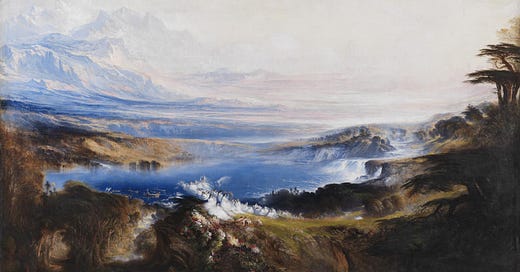Of all the colors, blue has arguably the greatest emotional purview. When its hues are soft and light, blue conveys the tranquility of a clear springtime afternoon or the freshness of a newly laid bird’s egg. When its hues are deep and vivid, blue conveys the dread of evening’s arrival and the chill of tumultuous waters. From the purest ease to the most striking fear, the evocative nature of the color blue cannot be understated.
Across time, blue has also been correlated with celestial themes. Famed depictions of eternal glory, such as English Romantic painter John Martin’s “The Plains of Heaven” shown below, tend to include rich bluish tones.1
Scripture is likewise not void of this color association. In the process of confirming the covenant made on Mt. Sinai, the Lord ushered Moses and the elders into a vision of the God of Israel displayed in radiance. The vibrant depiction follows as such.
Moses and Aaron, Nadab and Abihu, and the seventy elders of Israel went up and saw the God of Israel. Under his feet was something like a pavement made of lapis lazuli, as bright blue as the sky. But God did not raise his hand against these leaders of the Israelites; they saw God, and they ate and drank.2
Yet written explorations of this theme are not limited to the Biblical text or imagery. In his piece entitled “Fragmentary Blue,” the renowned American poet of the 20th century draws similar heavenly correlations. Yet one must begin with an autobiographical understanding of Robert Frost before endeavoring to decipher his complex artistry.
Frost as a character has been riddled in mystique. In an early letter written to a friend, he commented “I have written to keep the over curious out of the secret places of my mind both in my verse and in my letters.”3 Across his vocational writing and public attempts at interviews, Frost remained firmly enigmatic. As articulated, he preferred the most hidden crevices of his mind to be exposed in his poetry. Yet even then, “Frost’s poems, as everyone knows, are sometimes difficult, always subtle, and in some degree elusive.”4 As Frost grew to prominence, many frustrated biographers groaned of his elusive written and personal nature. Yet the poet responded emphatically that “I contain opposites…I’m not confused. I’m only well mixed.” “I am the conflicts, I contain them.”5
Frost’s spiritual life must also be approached with this conflictual understanding. Though much of his work references a divine being, “Doubts were as much a part of his trial by existence as faith, aspiration, and all-too-human moods.”6 And this doubt only intensified with his wife Elinor's declaration of atheism after the shattering grief of the death of their firstborn child. As a spirited and firm woman, Frost wrote that "Elinor has just come out flat-footed against God." After her own death, He continued to write that her impassioned rejection had "colored" his thought "from the first," and "through the rest of his days her atheistic certainty never quite left his mind despite his determined self-dedication to faith and belief."7
Aptly, for much of Frost’s spiritual journey he reflected on the passage “Lord, I believe; help thou mine unbelief.”8 And though his faith at many times remained shrouded in mystery, his poetry continued to be haunted with transcendence. Of his own writing he eloquently commented, "My poems—I should suppose everybody's poems—are all set to trip the reader head foremost into the boundless."9
And so he does in his remarkable poem, “Fragmentary Blue.”
Why make so much of fragmentary blue
In here and there a bird, or butterfly,
Or flower, or wearing-stone, or open eye,
When heaven presents in sheets the solid hue?
Since earth is earth, perhaps, not heaven (as yet)—
Though some savants make earth include the sky;
And blue so far above us comes so high,
It only gives our wish for blue a whet.10
As Frost reflects on the loveliness of common blue items, he speaks to the way in which they glimmer one’s divine longing. As he notes, humanity prizes the radiance of blue as seen in birds, butterflies, flowers, wearing-stones, and open eyes. These vibrant elements are readily admired. Yet in a curious tone, Frost prompts his readers to question why blue holds such a sway, especially when “heaven presents in sheets the solid hue?” Though the allure of sapphire beckons attention, the color only reflects a grander reality. Since earth is not yet heaven, as Frost remarks, these azure components only give “our wish for blue a whet.” They simply rouse the appetite for divine beauty.
And although Frost’s spiritual contemplations were often etched in doubt, he remained certain of this oncoming magnificence as displayed in fuller colors. When asked by a friend if his “redeemer liveth,” Frost responded with “Oh, I don’t know…but I do know there’s such a thing as redemption.”11 The eschaton which approaches with the return of Christ is what will finally renew the fragmented beauty of heaven and earth. With this redemption sure, the bluish remnants of wonder, upon which Frost reflects in his poem, feed this longing for divine fellowship and our eternal homeland.
Image sourced from Tate: https://www.tate.org.uk/art/artworks/martin-the-plains-of-heaven-t01928.
Exodus 24:9-11, NIV.
As quoted by Stanley Burnshaw, Robert Frost Himself (New York, NY: George Braziller Inc., 1986), 243.
Ibid, 285.
Ibid, 241 and 289.
Ibid, 295.
Ibid, 249.
Mark 9:24, KJV.
Burnshaw, Robert Frost Himself, 284.
Robert Frost, “Fragmentary Blue,” The Poetry Foundation, https://www.poetryfoundation.org/poems/148650/fragmentary-blue.
Burnshaw, Robert Frost Himself, 295.





"the bluish remnants of wonder" -- stunning, Emma.
Beautiful, Emma! Eloquently put and theologically rich.